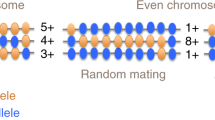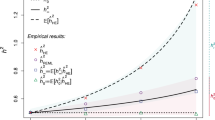Summary
The effect of assortative mating on the genetic correlation between traits X and Y is considered. Assortation on trait X changes the magnitude of the genetic correlation but not its sign. There are two situations depending on the signs of the correlation between mates (ρ) and of the random mating genetic correlation (θ): 1) if sign (θ) = sign (ρ), then θ >θ, where θ is the genetic correlation at equilibrium after continued assortation, and 2) if sign (θ) ≠ = sign (ρ), then θ < θ. However, negative assortative mating is virtually powerless to alter the magnitude of the genetic correlation. The consequences of a “mixed” assortation model, e.g., high milk production females mated to fast growing males and lesser productive females mated to slower growing sires, were also studied. “Mixed” positive assortation always increases the genetic correlation, but negative assortation decreases it. The implications of assortative mating on correlated responses to selection and on the equilibrium covariances between relatives for pairs of traits are discussed.
Similar content being viewed by others
Literature
Bulmer, M.G. (1980): The Mathematical Theory of Quantitative Genetics. Oxford: Clarendon Press
Crow, J.F.; Felsenstein, J. (1968): The effect of assortative mating on the genetic composition of a population. Eugen. Quart. 15, 85–97
Dishman, W.A.; Berger, P.J.; Freeman, A.E. (1981): Evaluation of merit of a corrective mating program for Holstein cattle. J. Dairy Sci. 64, 86 (Absta.)
Fisher, R.A. (1918): The correlation between relatives on the supposition of Mendelian inheritance. Trans. Roy. Soc. Edinburgh 52, 399–433
Jennings, H.S. (1916): Numerical results of diverse systems of breeding. Genetics 1, 53–89
Jensen, P.; Craig, H.B.; Robison, O.W. (1967): Phenotypic and genetic association among carcass traits of swine. J. Anim. Sci. 26, 1252–1260
Latter, B.D.H. (1965): Quantitative genetic analysis in Phalaris tuberosa. I. The statistical theory of open pollinated progenies. Genet. Res. 6, 360–370
Lush, J.L. (1948): The Genetics of Populations. Ames: Iowa State University
Reeve, E.C.R. (1953): Studies in quantitative inheritance. III. Heritability and genetic correlation in progeny tests using different mating systems. J. Genet. 51, 520–542
Reeve, E.C.R. (1961): A note on non-random mating in progeny tests. Genet. Res. 2, 195–203
Wentworth, E.N.; Remick, B.L. (1916): Some breeding properties of the generalized Mendelian population. Genetics 1, 608–616
Wright, S. (1921): Systems of mating. Genetics 6, 111–178
Author information
Authors and Affiliations
Additional information
Communicated by D. Van Vleck
Rights and permissions
About this article
Cite this article
Gianola, D. Assortative mating and the genetic correlation. Theoret. Appl. Genetics 62, 225–231 (1982). https://doi.org/10.1007/BF00276244
Received:
Issue Date:
DOI: https://doi.org/10.1007/BF00276244




